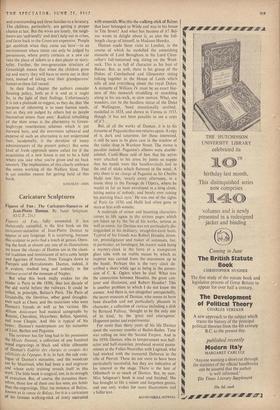Caricature Sculptures
rigures of Fun : The Caricature-StatueGes of Jean-Pierre Dantan. By Janet Seligman. (0.U.P., 21s.)
Figures of Fun, fully annotated if less elaborately compiled, is the first book on the caricature-statuettes of Jean-Pierre Dantan to appear in any language. It is surprising, because this sculptor in pelt° had a touch of genius. Open- ing the book at almost any one of its illustrations We know the charges of Dantan are in the classi- cal tradition and reminiscent of terra-cotta lamps and figurines of bronze, from Tanagra down to Pompeii and Herculaneum. Dantan, indeed, it IS evident, studied long and ardently in the cabinet secret of the museum of Naples.
But what this book really evokes for the reader is Paris in the 1830s, that last decade of the old world before the railways. It could be called, in principle, Balzae's Paris. The Paris of Grandville, the Deverias, other good draughts- men such as Chain, and the musicians who were Dantan's friends as well as his victims. His Album A tnicoruni had musical autographs by Rossini, Cherubini, Meyerbeer, Bellini, Spontini, and even Chopin. And this is typical of his tastes : Dantan's masterpieces are his statuettes of Liszt, Berlioz and Paganini.
The reviewer has for long had in his possession the Musk Dantan, a collection of one hundred wood engravings in black and white silhouette of Dantan's Galerie des charges et croquis des celebrites de l'epoque. It is, in fact, the sale cata- logue of Dantan's statuettes, and the woodcuts are by Maurisset, who had been a seal engraver and whose early training reveals itself in this Work. The little book is magical, too, in its strength of evocation. But, of course, the statuettes them- selves, those few of them one has seen, are better than the engravings. That, for instance, of Balzac, known as la cantle de Balzac, for it is a caricature of his famous walking-stick of ivory encrusted with emeralds.Was this the walking-stick of Balzac that later belonged to Wilde and was in his house
in Tite Street? And what has become of it? Bal- zac wrote in delight about it, as also the full- length charge of himself, to Madame Hanska.
Dantan made three visits to London, in the course of which he modelled the astonishing statuette of Lord Brougham in his Lord Chan- cellor's full-bottomed wig sitting on the Wool- sack. This is as full of character as his bust of Balzac. But, as well, there is his group of the Dukes of Cumberland and Gloucester sitting talking together in the House of Lords which tells all and everything about the royal Dukes. A statuette of William IV must be an exact like- ness of this monarch straddling or stumbling along in his sea-walk, in slow motion. What, one wonders, can be the headless statue of the Duke of Wellington, 'head intentionally omitted, modelled in 1833, and shown in Vienna in 1933, though 'it has not been possible to see a copy of it'?
But, of all the works of Dantan, it is to his statuette of Paganini that one returns again. A copy of it, dark and saturnine, for those interested, is still be seen in its glass case in the window of the violin shop in Wardour Street. The stance is peculiar indeed. Paganini's elbows were double- jointed; Castil-Blaze said of him that his wrists were attached to his arms by joints so supple that his hands were like handkerchiefs tied to the end of sticks which fluttered in the wind. A pity.there is no charge of Paganini as Sir Charles Halle saw him, 'nearly .every afternoon, in a music shop in the Passage de l'Opera, where he would sit for an hour enveloped in a long cloak, taking notice of nobody, and barely ever raising his piercing black eyes.' He was one of the sights of Paris (in 1838) and Halle had often gone to stare at him with wonder.
A multitude of minor and haunting characters comes to life again in the sixteen pages which are taken up by the list of his works, serious as well as comic, for Dantan was not particularly dis- tinguished in his Ordinary, straightforward busts. Typical of his friends was Robert Houdin, inven- tor, prestidigitator and maker of automata, but, in particular, an horologist, his master work being a mystery-clock in the form of a transparent glass tube with no visible means by which its impetus was carried from the movement up to the hands. Perhaps this is the very clock de- scribed a short while ago as being in the posses- sion of C. K. Ogden when he died. What was the connection between Houdini, the great con- jurer and illusionist, and Robert Houdin? This is another problem to which I do not know the answer. And there is, not altogether unexpectedly, the secret museum of Dantan, who seems to have been dwarfish and not particularly pleasant in character, a collection of curiosa including a dish by Bernard Pallissy, 'thought to be the only one of its kind,' by the 'great and courageous' Huguenot potter and experimenter.
For more than thirty years qf his life Dantan spent the summer months at Baden-Baden. Time was rolling on into the Second Empire. And in the 1850s Dantan, who in temperament was half- actor and half-musician, produced several panto- mimes at the Folies-Nouvelles with Legrand, who had wbrked with the immortal Deburau in the role of Pierrot. These do not seem to have been particularly successful, but they are indicative of his interest in the stage. There is the hint of Offenbach in so much of Dantan. But, by now, Miss Seligman's book is read and finished. She has brought to life a minor and forgotten genius, and one only wishes for more illustrations and a fuller text.
SACHEVERELL S111VELL


































 Previous page
Previous page